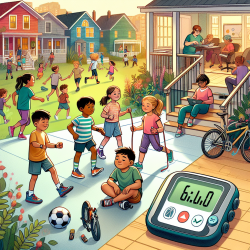Introduction
As a speech-language pathologist dedicated to improving children's outcomes, understanding the role of physical activity in child development is crucial. A recent study published in the International Journal of Behavioral Nutrition and Physical Activity sheds light on the factors influencing pedometer-based physical activity among elementary school children. This blog explores how practitioners can leverage these findings to enhance their interventions and encourage further research.
The Study: A Snapshot
The study examined the individual, social, and built environmental correlates of physical activity among children aged 10-12 years in Perth, Western Australia. Researchers used pedometers to measure steps taken by children, identifying cut-points of ≥15000 steps/day for boys and ≥12000 steps/day for girls as benchmarks for sufficient physical activity.
Key Findings
- Only 25.9% of children met the pedometer-based cut-points, with girls more likely to achieve these than boys.
- Factors negatively associated with meeting the cut-points included being male and having more neighborhood destinations within a 10-minute walk.
- Positive associations included reduced screen time (<2 hours/day), not being driven to school, attending a school in a high SES neighborhood, and higher average steps among peers.
Implications for Practitioners
These findings offer valuable insights for practitioners seeking to promote physical activity among children:
- Screen Time Reduction: Encourage parents to limit children's screen time to less than two hours per day. This could be integrated into parent education programs or workshops.
- Active Transportation: Advocate for walking or cycling to school. Schools can implement 'walk to school' days or provide safe routes for students.
- School Environment: Schools in high SES neighborhoods showed better outcomes, suggesting that fostering a supportive and active school environment can be beneficial. Consider advocating for policies that enhance physical activity opportunities in schools.
Encouraging Further Research
While the study provides a solid foundation, there is room for further exploration:
- Investigate the impact of neighborhood safety and aesthetics on children's physical activity.
- Examine the role of peer influence in promoting physical activity, especially in different socio-economic contexts.
- Explore interventions tailored to boys, who were less likely to meet activity benchmarks.
Conclusion
By understanding and implementing the study's findings, practitioners can develop targeted interventions to enhance physical activity among children. These efforts not only contribute to better physical health but also support overall developmental outcomes.
To read the original research paper, please follow this link: A cross-sectional study of the individual, social, and built environmental correlates of pedometer-based physical activity among elementary school children.










